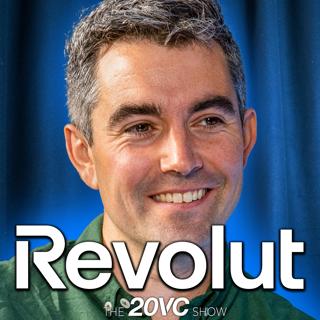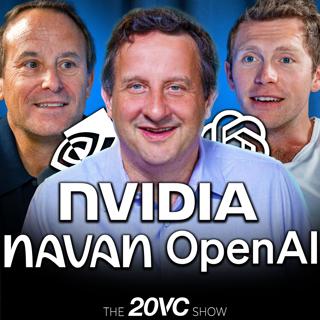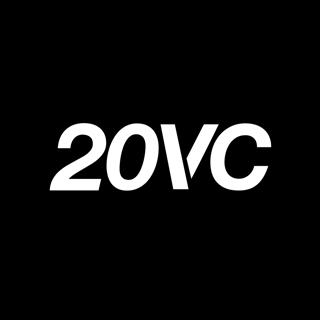
20VC: OpenAI and Anthropic Will Build Their Own Chips | NVIDIA Will Be Worth $10TRN | How to Solve the Energy Required for AI... Nuclear | Why China is Behind the US in the Race for AGI with Jonathan Ross, Groq Founder
Jonathan Ross is the Founder & CEO of Groq, the AI chip company redefining inference at scale. Under his leadership, Groq has raised over $3B from top investors. The company has reached a valuation of nearly $7B, positioning itself as one of NVIDIA's most formidable challengers. Previously at Google, Jonathan led the team that built the first Tensor Processing Unit (TPU), making him one of the leading architects of modern AI hardware. AGENDA: 00:00 The Future of AI and Compute 05:07 Why the Hyperscalers Have to Keep Spending Recklessly on AI 12:49 Why OpenAI and Anthropic Will Have to Build Their Own Chips 19:47 OpenAI and Anthropic Will be $5BN Companies: The Bull Case 29:50 Why China is Behind the US in AI and Deepseek is More Expensive to Run 33:55 How Europe Could Compete in AI and Why the US is More Risk Averse Than Europe 42:51 Why AI Will Lead to Too Many Not Too Few Jobs 43:19 Deflationary Pressures and New Job Markets 45:51 The Future of Vibe Coding 47:14 Why AI Companies Should Strive to Have Low Margins 49:31 Why We Have to Have Nuclear Energy and How to Bring it Back 56:55 How Permits are Ruining the Potential of AI 01:03:58 Why OpenAI and Anthropic are so Undervalued 01:16:53 Quickfire: Biggest Fear, Nvidia: $10TRN, Zuck Buying AI: Work or Not
29 Sep 1h 21min

20Product: Revolut Business $1BN Revenue: Five of the Biggest Product Lessons | How Revolut Structures Product and Design Teams | How Revolut Experiments and Invests in New Product Bets | How Revolut Ships Product So Fast with James Gibson
James Gibson is Head of Revolut Business. Under his leadership, Revolut Business now processes over $33 billion in monthly transaction volume and generates more than $1BN in annualised revenue. AGENDA: 04:10 Is Consulting the Worst Background for Aspiring PMs 07:09 How Revolut Hires for it's Product Team 17:21 How Revolut Sets Goals: What Works, What Does Not 19:37 How Revolut Structures Their Product Teams 22:13 How Revolut Structures Product Review Sessions 27:23 New Bets Process at Revolut 29:11 How Revolut Balances Super Users and General Customers 36:55 How Revolut Drives Product Velocity and Efficiency 39:26 Future of Product with AI 44:56 Quick Fire Questions and Reflections
26 Sep 54min

20VC: NVIDIA Invests $100BN Into OpenAI | Is Triple, Triple, Double, Double Dead | Navan Files to go Public & Notion Hits $500M ARR | The Impact of H1B Visas on Startups in the US
AGENDA: 00:00 Why I am 100% Equities and 0% Cash 04:35 Nvidia's Massive $100BN Investment in OpenAI 08:39 Is Anthropic Negatively Positioned by OpenAI Gaining NVIDIA Investment 27:30 Is Triple, Triple, Double, Double Dead 44:00 Navan Files to Go Public at $8BN 49:31 Lockup Periods and Liquidity 50:35 Impact of H-1B Visa Changes on Startups 01:02:42: Notion Hits $500M ARR Re-Accelerating 01:09:42 Why Founder Friendly is Total BS Today
25 Sep 1h 19min

20VC: General Catalyst CEO Hemant Taneja on The Future of Venture Capital: Chanel vs Walmart | Lessons Scaling GC to $40BN in AUM | Investing $5BN+ Into Stripe Over 14 Rounds | Investing Hundreds of Millions into Anthropic at $60BN Valuation
Hemant Taneja is the CEO and leader of General Catalyst, the firm he has scaled over the last decade into one of the largest with over $40BN in AUM. He has been one of the most influential investors of the past two decades, leading early bets in Stripe, Snap, Gusto, Samsara, Grammarly, and Canva. He also played a pivotal role in Livongo's $18.5B merger with Teladoc, one of the largest digital health deals in history. AGENDA: 00:00 Introduction 03:37 Is Hemant a CEO or an Investor? 05:42 With $40BN AUM Is General Catalyst Still a VC Firm? 12:11 Has Trump Done More to Hurt or Help the US? 13:25 No One is Talking About the True Impact of AI on Jobs 21:30 Is Hemant Concerned by the Concentration of Value in MAG 7? 27:30 Has Trump Done More to Hurt or Help the US? 30:27 GC's Anthropic Investment: Upside from a $60BN Price 37:06 Do Margins Matter in a World of AI 45:23 Does Revenue Growth Matter in a World of AI 49:39 Why it is BS to Turn Down a Company Based on Price 56:06 We Have Invested $5BN Into Stripe Over 14 Rounds 01:00:02 VC is About To Be Flooded with Retail Investment: What Does It Mean for VC 01:08:51 "What I Learned Losing the Series A of Snap, Stripe, Samsara" 01:11:25 Future of Venture Capital: Walmart vs Chanel
22 Sep 1h 27min

20VC: Why 90% of Founders Build Startups Wrong | Why AI Growth Rates are Sustainable & Remote Work is BS and the AI Talent War | Competing with Brett Taylor and Sierra: Who Wins the Customer Service War with Jesse Zhang, Decagon
Jesse Zhang is the Co-Founder and CEO @ Decagon, the conversational AI platform for customer experience. As one of the fastest growing companies in the valley, they have raised over $230M at a last round price of $1.5BN. Prior to Decagon, Jesse founded Lowkey (acquired by Niantic), studied CS at Harvard, and worked at places like Google, HRT, Citadel, and Intel. AGENDA: 00:00 Introduction and Sponsor Messages 03:43 Olympiad Mathematician to Startup Founder 05:34 Selling to Niantic and What I Did Differently the Second Time 07:16 Why 90% of Founders Build Companies the Wrong Way 12:19 Scaling to $50M ARR in 15 Months 31:31 Is the AI Talent War Out of Hand: How To Compete with Meta Pay Packets 32:38 Why Remote Work is Total BS 34:06 Competitors in AI Customer Experience: Sierra, Intercom and more 37:34 AI Market Predictions 44:56 Embracing Stress and Winning Culture 50:13 Quick Fire Questions: Most Underrated AI Founder, Biggest Changed Opinion
19 Sep 59min

20VC: Opendoor's CEO on The Greatest Turnaround in Tech | OpenAI and Oracle: How Can Either Afford to Do This | How Anthropic Could Lose 50% of Their Revenue Overnight | Replit Raises at $3BN | Figure, Gemini & VIA IPOs Broken Down
AGENDA: 00:00 Opendoor's Potential and Market Valuation 03:32 Why Did Kaz Leave $300M on the Table to Join Opendoor 04:44 Why Does Kaz Believe OPEN Can Be a Good Business When the Market Doesn't 06:34 How does Kaz Feel About OPEN Becoming a Meme Stock? 17:25 Kaz's $0 Salary but $1BN Stock Based Compensation 23:41 Oracle and OpenAI Partnership: WTF is Going On? 42:21 Microsoft's Investment in OpenAI: A Financial Perspective & Who Has the Power 44:46 Why Sam Altman is the Greatest Politician of our Time 48:33 How Anthropic's Revenue Could Go to Zero Overnight? 50:12 Replit Raises $250M at $3BN Valuation and Higgsfield Raises $50M at $50M ARR 01:06:33 IPO Insights: Figure, Gemini, and Via All Go Public 01:11:26 Why Adobe Have Failed in an Age of AI and What Incumbents Have To Do? 01:13:20 Quick Fire Round: Adobe Up or Down by EOY? What Price Will OPEN Be EOY? Try NEXOS.AI for yourself with a 14-day free trial: https://nexos.ai/20vc
18 Sep 1h 24min

20VC: Mercor: From $1M to $500M in 17 Months: The Fastest Growing Company in the World | How to Think About Margins and Revenue Sustainability in AI | Why Evaluation Benchmarks in AI are BS Today with Brendan Foody
Brendan Foody is the Co-Founder and CEO @ Mercor, the fastest growing company in history. The company solves talent allocation in the AI economy and they have scaled from $1M to $500M in revenue in just 17 months. With a rumoured new funding round pricing the company at a whopping $10BN, the company has the likes of Benchmark, Felicis, Emergence, and of course, 20VC, all on their cap table. AGENDA: 04:34 Why My Mother Thought I Was Selling Drugs as a Kid 07:48 In The Time My Peers Graduated, I Created a $10BN Business; Is College Worth it? 10:27 Scale, Surge, Mercor, Turing: How Do Data Providers Differentiate 20:57 Scaling from $1M to $500M: We Quadrupled Since Scale was Acquired 33:43 Is There Too Much Cash in Private Markets? 34:55 Why Evaluation Benchmarks in AI are Total BS 35:44 Revenue Sustainability in AI Companies 36:48 Should Investors Give a S*** About Margins When Analysing AI Companies 40:46 The Future of AI Model Providers: Who Wins 45:58 You Cannot Create a $10BN Company without 9-9-6 Work Culture 48:56 We Literally Have Too Much Money, We Cannot Spend It… 52:36 Quick Fire Round: OpenAI vs Anthropic, Lessons from Peter Fenton and Jack Dorsey
15 Sep 1h 1min

20VC: Why AI SDRs are BS and Do Not Work | How to Use AI in Your Sales Team and Process to Win Today | What Skills Do All New Reps Need to Have in an AI First World with Amit Bendov, CEO @ Gong
Amit Bendov is Co-Founder & CEO of Gong, the leading AI-sales platform. The company has raised over $600 million from some of the best in the world including Sequoia, Thrive, Salesforce and more. Gong has surpassed $300M in ARR, serves thousands of customers (including multiple Fortune 10s), and is valued at over $7BN. AGENDA: 00:00 – Why CRM Was Always a Lie and Gong's Secret Insight 04:30 – Will AI Kill Salesforce? Mark Benioff's Nightmare 08:15 – Why 99% of VCs Said No to Gong's Seed Round 12:00 – The Shocking Trial Close That Changed Everything 18:00 – Can AI Make Every Seller Perform Like LeBron? 20:30 – Will Sales Software Shift from Software Budget to Human Labor Budget? 25:00 – Why AI SDRs Are "Stupid" and Bound to Fail 35:00 – Gong's Darkest Hour: Shrinking, Churn, and Losing Muscle 41:30 – The Re-Acceleration Playbook: How Gong Got Back to Hypergrowth 54:00 – Would Amit Ever Sell Gong—or Take It Public?
12 Sep 1h 6min






















